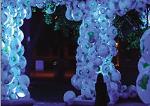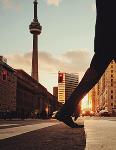By Al Ruggero
In the early sixties, parents moved families from Little Italy on College Street to the new neighbourhoods in Downsview. Children could play road hockey with real nets. They shouted “CAR”when the vehicles approached, and we did a lot of shouting when we played. We moved the nets, froze and glared at the audacious driver who dared cross. Fast forward to today’s kids, and the new normal is indoor rinks, and we don’t often see or hear them playing in the streets.
Today, the streets are part of the legacy of the old suburbia left behind in the push for the new urban imperative. The need to accommodate higher densities with better land use planning. We witness more infill housing on smaller parcels with less setbacks to the road, and more combinations of mid to high rise buildings. The densities and narrow streets found in downtown neighbourhoods have come to the suburbs. Roads are re-purposed to make better use of them. It is easy to blame traffic nightmares on higher densities. But it is not that simple, nor is the answer to go back.
Full disclosure, I work at Emery Village Business Improvement Area as Project Manager overseeing streetscape improvement and beautification projects. Our mandate is to improve and beautify the employment communities and gateways to benefit the local residents while supporting the commercial viability and sustainability for the area.
In one project, the street has commercial buildings on the west side, flanked by residential semi-detached on the east side. The road was narrowed to create lay by parking by the curb. The widened boulevard allowed benches, pedestrian lighting, banners, flower boxes and trees. Seasonally, the trees are lit to enhance pedestrian experience.
While the locals were hesitant to lose a wide roadway, they have come to enjoy the new surroundings. It succeeded in reducing the vehicle speeds, while providing additional parking spaces and safety for pedestrians and shoppers. These award-winning streetscape projects at Plunkett Road and Satterly Road in the Humber Summit community have served as benchmarks and have garnered praise from both the City of Toronto and TABIA (Toronto Area Business Improvement Associations).
In the sixties, Don Mills became Canada’s first planned suburb, defining how the city would grow. Today, Google’s parent company Alphabet is using our revitalized Waterfront to experiment with what tomorrow’s streets will look like. Just when my generation is accepting the dominance of Smart Phones, we will eventually have to come to terms with Smart Streets as well.
Most of us agree that the status quo is gridlock. This reality shapes our neighbourhoods, and influences many aspects of our lives. Where we choose to live and work is more and more guided by commuting times and access to transit rather than distance. The choice for young people on the cusp of their careers is even more difficult. As people change jobs and careers, they face less certainty over establishing roots in any given neighbourhood, making them less vested in it.
In the past, as the city grew, the solution to congestion was to build new roads and add more subdivisions. We can no longer do that. It is called urban sprawl, and has more than anything else, contributed to many of the traffic issues we now face. The automobile was foremost in mind when city planners mapped out Toronto’s road grid. For the typical family the automobile had few rivals on their wish list.
Over time the car has lost its pre-eminence in the planning of our road networks and in the exclusive use of the street. Nothing speaks more to this than the planned growth of transit over car lanes. Along comes Google (Alphabet’s streets), to save us from ourselves.
What’s in store, we’re not entirely sure, but some things we know. Smart Sensors embedded in the roads and sidewalks will hopefully gather useful data in REAL TIME (ask your kid what that means, I’m just a scribe) that could change stop light timing, traffic flow and other useful measures to help us get around.
Sound monitors could also be in the works. The data is to help in the design and safety of future street and sidewalks (Clearways in tech terms). If you’re still not impressed, people are working on surfaces that would melt ice, provide reflective lighting and offer us better grip during bad weather. Scientists are even working on surfaces that either made from excess airborne carbon or absorb it to lessen the carbon footprint that effects climate change.
The answers lie not in a return to the nostalgia of the past, but to seek out answers that may be at our feet. Our job is to join the discussion of the use and build public spaces that invite us to be there, not just to drive away.



















